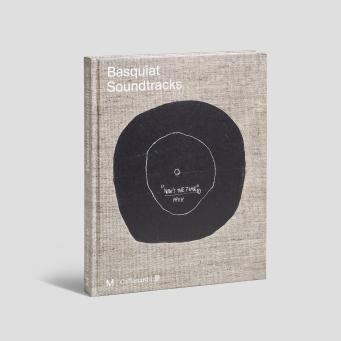The Philharmonie de Paris is organizing the first-ever exhibition dedicated to Jean-Michel Basquiat’s powerful relationship with music. A feast for the ears as well as the eyes, Basquiat Soundtrack presents a rich and heroic score to the meteoric output of a peerless artist, offering new insight into how his visual work was informed by music – from Beethoven to Madonna, zydeco to John Cage, Louis Armstrong to the Zulu Nation.
At the confluence of no wave and hip-hop
Jean-Michel Basquiat emerged as part of the multidisciplinary artist community of late-1970s New York, bursting onto the scene at the confluence of two surging musical movements: no wave and hip-hop.
A poet, stylist, sculptor and, especially, musician before he became a painter, Basquiat was the unofficial leader of the band Gray, which shared stages with major no wave groups like DNA and The Lounge Lizards. As a burgeoning creator, he frequented the downtown clubs that were an enclave for a generation of punk-influenced artists who, between performance art and experimentation, sought to forge new practices and bring art back to life. At the same time, Basquiat was hit hard by the onslaught of hip-hop, a cultural revolution unfolding uptown, developing its own codes and approaches to not only music but also dance and visual arts. He became close to the hip-hop community, even teaming up with rapper and MC friends to produce a single called Beat Bop (1983), featuring one of the trailblazers in the genre, Rammellzee.
Carrying the legacy of jazz
While hip-hop connected with the lineage of bebop, jazz also held a key place in Basquiat’s paintings. He placed himself within New York’s African-American cultural heritage, linking himself to an artistic lineage with no equivalent in the fine art world. Haunted by the tragic fate of Charlie Parker, the figure of a ravaged genius, Basquiat filled his works with references to jazz musicians and records. His understanding of the genre profoundly changed the composition of his paintings. From the Mississippi Delta, birthland of the blues, to the coasts of Africa and the Caribbean, to which he was linked by Haitian and Puerto Rican ancestry, Basquiat’s work explores the Black Atlantic, the intangible, diasporic continent where music is a place of memory: his work bears witness to a spiritual continuum through the ages, embodied in the ancestral figure of the griot.
A multisensory immersion in a vast body of work
Bringing together an extraordinary ensemble of almost one hundred artworks, this exhibition is an immersive experience, plunging us into the places and sounds that shaped Basquiat’s artistic evolution and fed his inspiration. The exhibition’s bold scenography shows his pictorial inventiveness in a new light, in which xeroxes are on the canvas what samples are to a song, and mixing appears as a structuring principle. Alongside the artworks, Basquiat Soundtrack presents rare archival documents, emblematic instruments and never-before-seen audiovisual media, providing new perspective on Basquiat’s work which, though closely linked to club culture – from the underground to the most flamboyant of 1980s nightclubs – has also revealed its universal dimension.
Curators:
Vincent Bessières, Dieter Buchhart, Mary-Dailey Desmarais.

With the collaboration of

Les Éditions de la Philharmonie
Basquiat Soundtracks
Le catalogue de la première exposition consacrée au rôle de la musique dans l’art de Basquiat, à la Philharmonie de Paris.
Media
Vincent Bessières présente l’exposition Basquiat Soundtracks
Basquiat Soundtracks est la première exposition qui explore la relation très féconde entre Jean-Michel Basquiat et la musique. La musique nous est apparue comme un sujet particulièrement pertinent pour non seulement mieux comprendre l’univers dans lequel il a émergé, l’environnement artistique qui était le sien, mais aussi son rapport à la forme, son rapport à l’histoire de la musique, à l’histoire américaine, même, d’une manière générale. Et donc la musique intervient à différents niveaux. Mais l’exposition va davantage vers ce qu’il représente, la thématique de ses tableaux, le fait que ses tableaux sont souvent sonores, bruyants, qu’ils représentent le son, des personnages qui font du bruit. Et puis, bien sûr, on examine aussi son rapport au jazz qui est, par essence, la musique noire américaine, et probablement la musique qu’il a le plus représentée, la musique la plus citée dans ses tableaux, et qui est pour lui une sorte de panthéon artistique, tout en allant au-delà du jazz, vers des formes plus populaires, plus vernaculaires comme le blues, la région du delta du Mississippi, qui constitue pour lui un espace géographique très important, avec l’horizon lointain de l’Afrique, qui était pour lui ce qu’il appelait « une mémoire culturelle ».
Dans un lieu comme la Philharmonie de Paris, il paraissait indispensable que la musique soit présente dans l’espace, pas seulement dans le discours, les explications, les tableaux. Qu’on puisse offrir au visiteur une expérience de visite qui ait une dimension sonore très forte. D’abord parce que Basquiat peignait en musique, il baignait dans la musique, il avait un rapport très fort et très intime à la musique. Et ensuite, il a fallu mettre en forme toute cette musique. On a privilégié l’image animée, les vidéos, de façon à montrer aussi les musiciens que Basquiat a vus et entendus. L’ensemble de tout ce contenu audiovisuel est piloté par un logiciel qui s’appelle Bronze, qui nous a été suggéré par Nicolas Becker, un designer sonore et ingénieur du son avec qui nous avons travaillé à l’élaboration de toute la partie sonore de l’exposition. Et ce logiciel a la capacité de puiser dans cette banque de musique et d’agencer le déroulement des morceaux en les enchaînant jamais de la même façon. Ce qui fait que, en fonction de l’heure ou du jour où on visite l’exposition, on n’entend pas la même chose.
Basquiat, on peut dire qu’il s’est auto-inventé, parce qu’en fait, il a construit son identité comme une espèce de mosaïque, en empruntant à droite et à gauche. Et effectivement, l’exposition s’attarde sur cette dimension-là. On a consacré tout un espace à Gray, le groupe de Basquiat en 1980. On montre aussi son implication dans la scène hip-hop, comment il a participé à l’émergence de soirées, comment il a même produit un single de rap qui s’appelle « Beat Bop », un très bon morceau. Basquiat utilise la musique pour parler de beaucoup de choses. La musique, pour lui, est étroitement corrélée à l’histoire des Etats-Unis et en particulier à la place qu’a occupée dans cette histoire la communauté afro-américaine, dont on sait qu’elle a donné naissance à beaucoup de musiques, à beaucoup de genres de musique qui ont d’ailleurs complètement nourri la musique populaire du XXe siècle.
Entretien : Tristan Duval-Cos
Réalisation : Clément Gaultier - Imaginé productions
Montage : Laurent Sarazin - Imaginé productions
© Cité de la musique – Philharmonie de Paris

Espace d'exposition - Philharmonie
See the venueGetting here
Porte de Pantin station
Paris Underground (Métro) Line 5
Tram 3B










